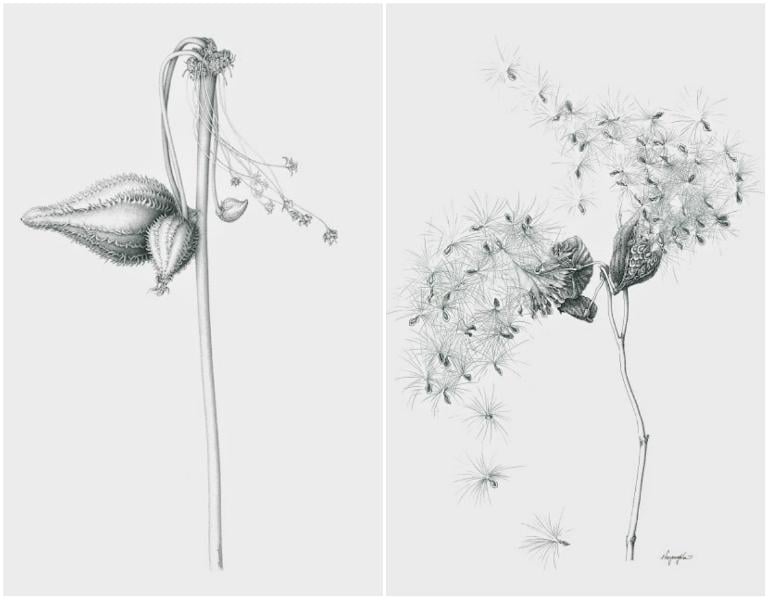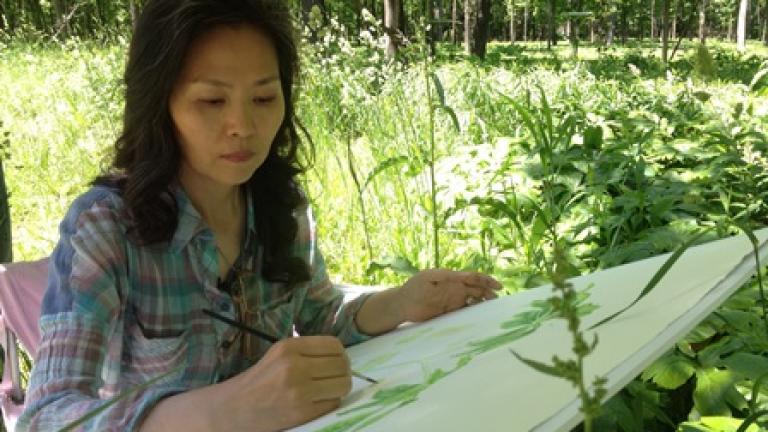When Heeyoung Kim moved here from Korea, she expected to find vast Midwestern prairies. When she learned that prairie and woodland ecosystems were endangered, she launched a personal crusade to paint and preserve 200 rare native plants. Kim also launched a fundraising campaign for Project 200. Jay Shefsky has her story.
TRANSCRIPT
Jay Shefsky: Ten years ago, Heeyoung Kim was a schoolteacher in Korea when her husband got a job that brought them and their young son to the Chicago area. Before she arrived, Heeyoung had a very clear, very wrong picture of the American Midwest.
Heeyoung Kim, botanic artist: I actually had a big expectation about the beautiful prairie landscapes—lots of open land, grasses, wildflowers in bloom endlessly. That was my imagination.
Shefsky: But when she arrived, she saw cornfields and manicured gardens but no prairies.
Kim: I could not find them anywhere. That was a shock to me, so I thought, Why are there no prairies?
Shefsky: Now, 10 years later, Heeyoung has made it her mission to document rare and endangered plants of the Midwest and to do it with botanically accurate paintings.
Tulip in watercolor (Heeyoung Kim)
Heeyoung Kim’s journey from disappointed immigrant to prolific botanic artist has something to do with this man, Stephen Packard.
He’s one of the region’s leading experts on prairie and woodland restoration. He also happened to be Heeyoung’s neighbor, and he grows rare plants in his yard.
Stephen Packard, conservationist: And there was Heeyoung with her somewhat new English at the time asking me questions about these plants. She was just fascinated with those plants.
Shefsky: Among Stephen’s many restoration efforts are these three acres of prairie and these 40 acres of woodland in the Somme Forest Preserve in Northbrook.
Stephen knows the area will never be fully restored, but he has a clear picture of what used to be here.
Packard: Up here would have been mountain lions and elk, and out in the prairie were wolves and bison. The amount of tall grass prairie that is left in Illinois is less than one one-hundredth of 1 percent. It’s not half gone, it’s not 90 percent gone, it’s not 99 percent gone. It’s one one-hundredth of 1 percent that’s left.
Shefsky: While Stephen was encouraging her love and knowledge of native plants, Heeyoung, who had not painted since childhood, took an art class on a whim.
Kim: And I realized, Oh, I can paint and I can draw.
Shefsky: And from the beginning she says all she wanted to paint was plants. But Stephen Packard wasn’t her only inspiration. Her father was an herbal medicine doctor in Korea and died when she was a child.
Kim: When I was young, I always followed my father to collect plants, and at home we have stacks of dried plants, and fresh dried plants, and everything.
Shefsky: So tell me about what you’re painting here.
Kim: I’m painting now mayapple woodland plant. It has beautiful white flowers, but it’s developing an apple right now.
Shefsky: Heeyoung’s paintings take up to 40 hours to complete. She takes careful measurements and creates many detailed sketches of the plant in all phases of its lifecycle before creating the finished watercolors. I asked why photography couldn’t serve the same purpose much more easily.
 Left: Common milkweed in graphite pencil. Right: Common milkweed (Asclepias syriaca) in ink (Heeyoung Kim)
Left: Common milkweed in graphite pencil. Right: Common milkweed (Asclepias syriaca) in ink (Heeyoung Kim)
Kim: Take picture is a good way, and quick and an effective way but this is an art form, an ancient art form—this botanic art.
Shefsky: And for Heeyoung Kim this is more than art. It’s education and activisim.
Kim: A really good way for public education is showing how beautiful and how precious and how important all these plants are in our lives. Painting them and let anybody, any institution can use those images for educational purposes and that is my mission.
Packard: When a person looks at one of Heeyoung’s drawings, their heart goes out to it. People say someone cared about this obscure little thing to put all of this work into it.
Kim: I just feel very humble when I sit around all of this wonderful nature. I’m given this kind of a gift to paint these and then all these subjects—my subject is very important: they will be gone in a few years when we don’t take care of them.
Shefsky: Heeyoung has set out to paint 200 rare and endangered plants. When she finishes those, she says she’ll paint the next 200.
Sign up for our morning newsletter to get all of our stories delivered to your mailbox each weekday.





